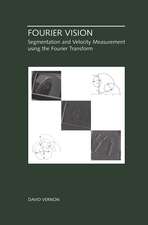Statistical Models of Shape: Optimisation and Evaluation
Autor Rhodri Davies, Carole Twining, Chris Tayloren Limba Engleză Hardback – 10 sep 2008
| Toate formatele și edițiile | Preț | Express |
|---|---|---|
| Paperback (1) | 646.47 lei 6-8 săpt. | |
| SPRINGER LONDON – 4 noi 2014 | 646.47 lei 6-8 săpt. | |
| Hardback (1) | 611.21 lei 38-45 zile | |
| SPRINGER LONDON – 10 sep 2008 | 611.21 lei 38-45 zile |
Preț: 611.21 lei
Preț vechi: 764.01 lei
-20% Nou
Puncte Express: 917
Preț estimativ în valută:
116.96€ • 125.07$ • 97.51£
116.96€ • 125.07$ • 97.51£
Carte tipărită la comandă
Livrare economică 14-21 aprilie
Preluare comenzi: 021 569.72.76
Specificații
ISBN-13: 9781848001374
ISBN-10: 1848001371
Pagini: 320
Ilustrații: XII, 302 p.
Dimensiuni: 155 x 235 x 19 mm
Greutate: 0.66 kg
Ediția:2008
Editura: SPRINGER LONDON
Colecția Springer
Locul publicării:London, United Kingdom
ISBN-10: 1848001371
Pagini: 320
Ilustrații: XII, 302 p.
Dimensiuni: 155 x 235 x 19 mm
Greutate: 0.66 kg
Ediția:2008
Editura: SPRINGER LONDON
Colecția Springer
Locul publicării:London, United Kingdom
Public țintă
ResearchCuprins
Statistical Models of Shape and Appearance.- Establishing Correspondence.- Objective Functions.- Re-parameterisation of Open and Closed Curves.- Parameterisation and Re-parameterisation of Surfaces.- Optimisation.- Non-parametric Regularization.- Evaluation of Statistical Models.
Textul de pe ultima copertă
Statistical models of shape, learnt from a set of examples, are a widely-used tool in image interpretation and shape analysis. Integral to this learning process is the establishment of a dense groupwise correspondence across the set of training examples.
This book gives a comprehensive and up-to-date account of the optimisation approach to shape correspondence, and the question of evaluating the quality of the resulting model in the absence of ground-truth data. It begins with a complete account of the basics of statistical shape models, for both finite and infinite-dimensional representations of shape, and includes linear, non-linear, and kernel-based approaches to modelling distributions of shapes. The optimisation approach is then developed, with a detailed discussion of the various objective functions available for establishing correspondence, and a particular focus on the Minimum Description Length approach. Various methods for the manipulation of correspondence for shape curves and surfaces are dealt with in detail, including recent advances such as the application of fluid-based methods.
This complete and self-contained account of the subject area brings together results from a fifteen-year program of research and development. It includes proofs of many of the basic results, as well as mathematical appendices covering areas which may not be totally familiar to some readers. Comprehensive implementation details are also included, along with extensive pseudo-code for the main algorithms. Graduate students, researchers, teachers, and professionals involved in either the development or the usage of statistical shape models will find this an essential resource.
This book gives a comprehensive and up-to-date account of the optimisation approach to shape correspondence, and the question of evaluating the quality of the resulting model in the absence of ground-truth data. It begins with a complete account of the basics of statistical shape models, for both finite and infinite-dimensional representations of shape, and includes linear, non-linear, and kernel-based approaches to modelling distributions of shapes. The optimisation approach is then developed, with a detailed discussion of the various objective functions available for establishing correspondence, and a particular focus on the Minimum Description Length approach. Various methods for the manipulation of correspondence for shape curves and surfaces are dealt with in detail, including recent advances such as the application of fluid-based methods.
This complete and self-contained account of the subject area brings together results from a fifteen-year program of research and development. It includes proofs of many of the basic results, as well as mathematical appendices covering areas which may not be totally familiar to some readers. Comprehensive implementation details are also included, along with extensive pseudo-code for the main algorithms. Graduate students, researchers, teachers, and professionals involved in either the development or the usage of statistical shape models will find this an essential resource.
Caracteristici
Addresses one of the key issues in shape modelling: that of establishing a meaningful correspondence between a set of shapes Uses a novel approach to establishing correspondence by casting model-building as an optimisation problem Includes practical examples of applications for both 2D and 3D sets of shapes Full implementation details, perviously unpublished, provided


























